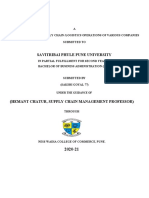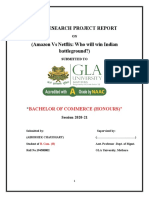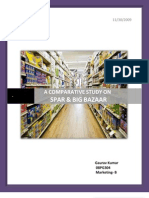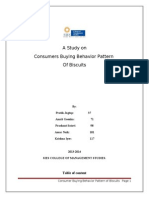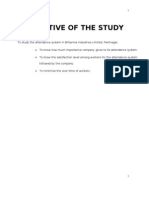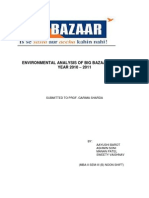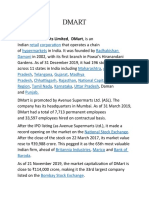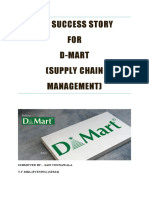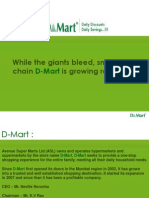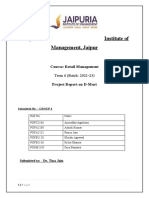Professional Documents
Culture Documents
Study On The Consumer Preference and Perception of Supermarket Chain - Case of Dmart
Original Title
Copyright
Available Formats
Share this document
Did you find this document useful?
Is this content inappropriate?
Report this DocumentCopyright:
Available Formats
Study On The Consumer Preference and Perception of Supermarket Chain - Case of Dmart
Copyright:
Available Formats
Volume 3, Issue 11, November – 2018 International Journal of Innovative Science and Research Technology
ISSN No:-2456-2165
Study on the Consumer Preference and Perception of
Supermarket Chain - Case of Dmart
M. Guruprasad
Director Research
Universal Business School
Abstract:- D-Mart is a one-stop supermarket chain that The core objective is to offer customers good products at great
aims to offer customers a wide range of basic home and value.
personal products. To understand customer preference
and perceptions on D Mart products and services. The DMart was started by Mr. Radhakishan Damani and his
study reveals that the customers are satisfied with the family to address the growing needs of the Indian family.
services. From the launch of its first store in Powai in 2002, DMart
today has a well-established presence in 163 locations across
Keywords:- Supermarket, retail, preference, perception, Maharashtra, Gujarat, Andhra Pradesh, Madhya Pradesh,
shopping, Karjat, Badalapur, DMart, ASL,UBS. Karnataka, Telangana, Chhattisgarh, NCR, Tamil Nadu,
Punjab and Rajasthan. With their mission to be the lowest
I. INTRODUCTION priced retailer in the regions we operate, their business
continues to grow with new locations planned in more cities.
Problem formulation The supermarket chain of DMart stores is owned and operated
The service industry and in particular, the retail market by Avenue Supermarts Ltd. (ASL). The company has its
has been vital to the world economy and undergone the ever headquarters in Mumbai. The brands D Mart, D Mart
intensified competition under recent crisis and economic turn- Minimax, D Mart Premia, D Homes, Dutch Harbour, etc are
down period. The modern retail industry is booming across the brands owned by ASL.
world. Therefore, it is essential for retailers to use strategies
which focus on satisfying current customers. Supermarkets II. OBJECTIVES OF THE STUDY
and Hypermarkets have played an important role in food
distribution since they appeared. For modern life, the To understand customer preference towards D-Mart
existence of traditional markets has been gradually replaced products.
by their descendent supermarkets and people depend on To know the customers shopping habits.
supermarkets for their basic grocery needs. Shopping at the To find out the consumer perception of D-Mart services.
grocery store has become a big deal and it is one of the most To find out the effect of D-Mart on competitor’s business.
important food sources for many households. In addition, To study the satisfaction level of customers of D- Mart.
unlike previous studies that have focused more on service
industry such as bank, healthcare, beauty etc, the researchers III. SCOPE OF THE STUDY
considered a supermarket setting which fully represents both
product and service characteristics The Indian retail industry The data was collected from the respondents across all
has emerged as one of the most dynamic and fast-paced the income groups, occupation and gender. The total sample
industries due to the entry of several new players. It accounts size for the study is 110. The study involves ascertaining the
for over 10 per cent of the country’s Gross Domestic Product customer perception towards various areas such as price,
(GDP) and around 8 per cent of the employment. India is the promotions offered, billing system and parking facility etc.
world’s fifth-largest global destination in the retail space. The study also tries to know why the customers visit and shop
at D-Mart and get valuable suggestions from them. So, the
India’s retail market is expected to nearly double to US$ study tried to get the responses almost all kinds of
1 trillion by 2020 from US$ 600 billion in 2015#, driven by respondents. This research is based on primary data and
income growth, urbanization and attitudinal shifts. While the secondary data. Due to time constraint, only limited number of
overall retail market is expected to grow at 12 per cent per persons contacted.
annum, modern trade would expand twice as fast at 20 per
cent per annum and traditional trade at 10 per cent. D-Mart is IV. RESEARCH METHODOLOGY
a one-stop supermarket chain that aims to offer customers a
wide range of basic home and personal products under one Study was conducted in the area of Karjat and Badlapur
roof. Each D-Mart store stocks home utility products - market. “Simple Random Sampling” is used in this study.
including food, toiletries, beauty products, garments, Sample Size of the study is 110 respondents. Data Collection
kitchenware, bed and bath linen, home appliances and more - is done from various customers through personal interaction.
available at competitive prices that the customers appreciate. Questionnaire (Interview Schedule) was prepared for
IJISRT18NV52 www.ijisrt.com 314
Volume 3, Issue 11, November – 2018 International Journal of Innovative Science and Research Technology
ISSN No:-2456-2165
collecting data. Majority questions in the Questionnaire were economic development, changes in the marketing and
close ended questions and a few open-ended questions. Data economic system as well as changing pattern and
was collected through primary as well as secondary sources. classification of economic activity.
Data collected is from D Mart Karjat and Badlapur. Data Hamilton Ryan (2009) in their research paper majorly
was collected as a part of experiential learning exercise which focused on the important decision that retailers always
is a unique learning process at UNIVERSAL BUSINESS involves in selecting the number of items constituting their
SCHOOL(UBS) by students and discussed in the classroom assortments. A key issue in making these decisions is the role
sessions as a case for Research Methodology subject. of assortment size in determining consumers choice of a
Precautions were taken to see that there was no bias and retailer. The authors address this issue by investigating how
correct methods of data collection were used. The collected consumer choice among retailers offering various-sized
data was analysed using SPSS software. assortments is influenced by the attractiveness of the options
constituting these assortments. The data show that consumer
V. LITERATURE REVIEW preference for retailers offering larger assortments tends to
decrease as the attractiveness of the options in their
Kotler and Armstrong (2012) define retailing as all the assortments increases and can even lead to a reversal of
activities for selling goods or services directly to ultimate preferences in favour of retailers offering smaller assortments.
buyers for their personal, non-business use. This research further presents evidence that the relationship
According to Amit & Kameshvari, (2012), the origin of between assortment size and option attractiveness is concave,
word “retail‟ comes from the French „retailer‟, that means „to such that the marginal impact of assortment size on choice
cut a piece off‟ or „to break bulk‟. In other words, it shows a decreases as the attractiveness of the options increases. Data
first hand-transaction with the customer The retailer is a from eight empirical studies offer converging evidence in
person or agent or agency or company or organization who support of the theoretical predictions.
sends the products or services to the ultimate consumer Thus, Krishnaveni (2006) identified that the most important
the customer and the fulfillment of customer desires and needs paradigm which is associated with promotion of loyalty
which are the key points of retailing are the retailing focus among consumers is the attribute of quality. Present
According to Tiwari,(2009),. Retailing is as old as generation invest more on the basic factors such as books,
exchange. Retailing is one of the oldest businesses in the clothes, food, music and gadgets such as mobile phones.
world and was practiced in prehistoric times. Earlier it was the Kuruvilla and Ganguli (2008) explained that shopping
exchange of food and traditional weapon which followed the develops into important aspect in the lives of people, as they
emergence of traders and peddlers. The day barter has been are becoming financially sound to do purchase in malls and
replaced by exchange through money (in any form) the they begin to consider the shopping value as an important
retailing came into existence A few centuries ago, in the 16th factor along with the price of the products. In 1990s the
and 17th centuries, some retail chains in some European cities modern trend in shopping mall concept had been introduced
were known.However, the beginning of retailing development by ‗Spencer Plaza‘in Chennai and ‗Crossroads‘in Mumbai.
is acknowledged to be at the end of the 19th century and early After that, there has been a great improvement in this modern
of the 20th century. At the beginning, retailers dominated with concept.
any merchandise. Later, retailers specializing in the market
began to gain momentum. Last few years, there are very large Dwivedi (2010) explained that when compared to major
stores, but again selling every kind of merchandise. In cities in India, the smaller cities seem to be a better place for
countries that have developed retailing, competition has investment. This is because these cities have low priced lands,
reached high levels and has again started focusing on low functional and operational expenses and greater number
specialized stores. of available lands. He further specified and explained that
there has been a transition in the taste and purchasing
According to Hansemark & Albinsson (2004), priorities of the customers from Tier II and III cities in the past
“satisfaction is an overall attitude towards a product provider ten years. He also presented the views of Ernst and Young
or an emotional reaction to the difference between what which illustrated that there was twenty six percentage of
customers expect and what they actually receive regarding the growth in mall of the metropolitan cities while malls in Tier II
fulfilment of a need”. Kotler (2000) also define satisfaction as and III cities showed fifty five percentage of growth.
a person’s feelings of pleasure, excitement, delight or
disappointment which results from comparing a products Bijapurkar (2008) explained that the reduction indicates
perceived performance to his or her expectations. the increase in the number of middle class populations who
can manage to pay for food, beverage and entertainment in
Nair Suja (2008) in her book ‗Retail Management‘ has addition to their basic needs. In India a great increase in
tried to explain the growth of retailing in Indian context family income has been observed.
especially in the context of new economic policy, global
IJISRT18NV52 www.ijisrt.com 315
Volume 3, Issue 11, November – 2018 International Journal of Innovative Science and Research Technology
ISSN No:-2456-2165
Feinberg, Sheffler, Meoli and Rummel (1989) keep-up of the city. Funds are generated essentially through
considered the social stimulation provided by malls, finding property taxes. Maharashtra State Assembly has two
that the mall served as an outlet for social behaviour. nominations from Badlapur. As per provisional reports of
Census India, population of Badalapur in 2011 is 174,226; of
C S Venkata Ratnam (2007) have detailed changing which male and female are 90,365 and 83,861 respectively.
consumer behaviour in retail trade in India in his paper Although Badalapur city has population of 174,226; its urban /
entitled “Changing Consumer Behaviour and Emerging metropolitan population is 18,394,912 of which 9,872,271 are
Challenges to the Retail Trade In India” The author has males and 8,522,641 are females.
highlighted that sustained and rapid growth of China and
India, which together provide home to over a fifth of the Now, let us understand the study findings of consumer
humanity, are creating a tremendous surge in consumerism on preference towards Dmart in these two locations.
a scale which is unprecedented. Both the countries are
attractive destinations for investment and production as well Shopping Trend
as sales and marketing. From the research conducted it can be inferred that
majority of the people in Badlapur visit the store in the
VI. ANALYSIS OF THE RESEARCH evening, whereas half of the population in Karjat visit the
store at that time. Slightly less than half in Karjat visit the
Locations: Now, let us analyse the brief profile of the store at night in comparison to Badlapur which is a very small
two locations where the research were conducted. percentage. Morning visitor in both the place is a small
Karjat an Overview minority. When it comes to offering D’mart products online
We look into the overall view of the location Karjat. The there was a divided opinion from customer from both the
basic information of these places was based on the Census location with half of respondents preferring the options.
2011 data provided by the Government of India. Karjat is a Majority of the customer in Badlapur and Karjat mentioned
Municipal Council city in district of Raigarh, Maharashtra. that they use their personal transport to get to the outlets.
The Karjat city is divided into 17 wards for which elections While as a minority use auto services to reach the outlet.
are held every 5 years. The Karjat Municipal Council has Mode of Payment
population of 29,663 of which 15,248 are males while 14,415
are females as per report released by Census India 2011.
Population of Children with age of 0-6 is 3039 which is 10.25
% of total population of Karjat (M Cl). In Karjat Municipal
Council, Female Sex Ratio is of 945 against state average of
929. Moreover Child Sex Ratio in Karjat is around 917
compared to Maharashtra state average of 894. Literacy rate of
Karjat city is 88.38 % higher than state average of 82.34 %. In
Karjat, Male literacy is around 91.65 % while female literacy
rate is 84.94 %. Karjat Municipal Council has total
administration over 6,820 houses to which it supplies basic
amenities like water and sewerage. It is also authorize to build
roads within Karjat Municipal Council limits and impose taxes
on properties coming under its jurisdiction. The area is well
connected with other places like Panvel, Mumbai, Thane and
Fig 1
Pune.
Badalapur an Overview
Badalapur is a city in Thane District of Maharashtra state
in India. Badalapur city is a group of 4 villages namely,
Katrap, Kulgaon, Badlapur & Manjarli. Over a period of time,
Badalapur has transformed into a major residential area,
comprising of various communities & people of different
cadre. Badalapur is typically known to Mumbai people as a
week-end picnic spot, as it hosts two major dams and few
waterfalls appear during monsoon. Its proximity to Mumbai
has transformed Badlapur into one of the major residential
zone. Although it is approx. 70 km from Mumbai main city,
its quiet surroundings, beautiful nature and somewhat cool
temperatures made it a place liked by many. Badalapur has a Fig 2:- Badlapur
Municipal Council which takes care of civic amenities and
IJISRT18NV52 www.ijisrt.com 316
Volume 3, Issue 11, November – 2018 International Journal of Innovative Science and Research Technology
ISSN No:-2456-2165
fruits offered. While another considerable amount said they
would like electronics to be sold. Large no of customers stated
that they spend Rs 1200 or more where they shop at either of
the store. Remaining said that they spend 700-1200 or less.
More than half of D’mart customer would like to be offered
fresh vegetable/fruits. Less than majority of customer want
electronics. A small amount of customers want fresh meats. A
lesser amount of customer want musical instruments and a
minority want in fresh flower offerings.
Fig 3:- Badlapur
As per the analysis 77% of the respondents visit the store
during evening, and 61% of the respondents pay through debit
card for their transactions.
Fig 6:- Karjat
Fig 4:- Karjat
Fig 7:- Karjat
Fig 5:- Karjat
As per the analysis 50% of the respondents visit the store
during evening and 48% visits during night, and 66% of the
respondents pay through debit card for their transactions. In
both the location majority of the purchases where done
through debit card and slightly more than a quarter said that
they paid using cash. Minority use credit cards. In Badlapur
majority of the customers visited the store once a month where
is in Karjat a slightly more than a quarter visited the store.
Almost half of people visit to the store 1 time in a month.
Slightly more than a quarter of people visit 2 times in a month. Fig 8:- Badalapur
Less than a quarter of people visit 3 times in a month as well
as 4 times a month and a minority of people visit more than 4
times in a month.
Product Preference
Majority of the customers in both the location purchased
confectionary, groceries, garments and stationary item from
the store. while a major point of difference was that very few
people in Karjat purchase kitchen and homeware products in
comparison to Badlapur. When asked what services the
customer would like to be offered a large majority of the
sample size stated that they would like fresh vegetable and Fig 9:- Badalapur
IJISRT18NV52 www.ijisrt.com 317
Volume 3, Issue 11, November – 2018 International Journal of Innovative Science and Research Technology
ISSN No:-2456-2165
minority. When it comes to offering D’mart products online
Majority shoppers rated 4 it means brand name is there was a 50-50 opinion from customer from both the
important for the consumers. A good brand has a major location. When finding out what motivates customer to shop
influence on the consumer. at D’mart majority of the customers in badlapur and karjat
said that its discount, convivences & offerings/variety that
Service quality satisfaction motivates them to shop at D’mart. Majority of the customer in
The improvement that would like to be seen by most of badlapur and karjat mentioned that they use their personal
the consumers was service, while some other members stated transport to get to the outlets. While as a minority use auto
that they would like to see improvements in infrastructure, services to reach the outlet. In both the location majority of the
layout and offerings. Majority of the respondent in both purchases where done through debit card and slightly more
regions were of the opinion that signage and store layout were than a quarter said that they paid using cash. Minority use
helpful, they also felt that the return policy was satisfying. credit cards. In badlapur majority of the customers visited the
Respondents overall had good experience with D’mart. When store once a month where is in karjat a slightly more than a
probed on what motivates customer to shop at D’mart majority quarter visited the store. Customer that visit the store twice,
of the customers in Badalapur and Karjat said that its discount, thrice and fourth time a month more or less the same.
connivances & offerings/variety that motivates them to shop at
D’mart.A large majority of respondents in Karjat and Majority of the customers in both the location purchased
Badlapur said that discounts and products offered were the confectionary, groceries, garments and stationary item from
biggest advantages D’mart has over its competitors. All the store. While a major point of difference was that very few
respondents in Badlapur and slightly more than a quarter in people in karjat purchase kitchen and homeware products in
Karjat said they would recommend D’mart to others. comparison to Badalapur. When asked what services the
customer would like to be offered a large majority of the
According to the analysis the consumer of D’mart are sample size stated that they would like fresh vegetable and
satisfied with the services provided by D’mart. Large majority fruits offered. While another considerable amount said they
of consumer prefer it. What contribute to the popularity of the would like electronics to be sold. Large no of customers stated
demand is the service quality of the service provided by that they spend Rs 1200 or more where they shop at either of
D’mart coupled with the attractive pricing strategy followed the store. Remaining said that they spend 700-1200 or less.
by it. D’mart also has huge variety of product all under one The improvement that would like to be seen by most of the
roof which is one of its largest competencies. Majority of the consumers was service, while other quadrants stated that they
people rated D’mart among it’s competitors as 4 out of 5 would like to see improvements in infrastructure, layout and
meaning good. Less than a quarter of the people rated as 5 offerings. Majority of the respondent in both regions were of
which indicates best. Far less than quarter rated as 3 it shows the opinion that signage and store layout were helpfull, they
quite satisfactory. Minority of people rated it 2 among its also felt that the return policy was satisfying. A large majority
competitors. of the respondents never had a bad experience with D’mart. A
Survey among Retailer large majority of respondents in Karjat and Badalapur said that
While analysing the competitor perception of D’mart it discounts and products offered were the biggest advantages
has been seen that D’mart has considerably of its competitor D’mart has over its competitors. All respondents in Badalapur
other reason for this is that the lack of ability of competitor to and slightly more than a quarter in Karjat said they would
cope up with changing preferences and market development recommend D’mart to others.
strategy prevalent in the market. D’mart mostly faces According to the analysis we conclude that the
competition from small shop which deal in single variety of consumers of D’mart are satisfied with the services provided
commodity. The only advantage that the competition has is the by D’mart. Large majority of consumer are loyal to brand
proximity to the Karjat market personal relation with the what contribute to the popularity of the demand is the service
consumer and existing brand image due to them being in the quality of the service provided by D’mart coupled with the
market for multiple generations. The competitions lack the attractive pricing strategy followed by it. D’mart also has huge
desire to expand, innovate and bring changes to their verity of product all under one roof which is one of its largest
businesses and are content with the current progress of the competencies. While analysing the competitor perception of
business but are in danger of becoming redundant. D’mart it has been seen that D’mart has considerably of its
VII. CONCLUSION competitor other reason for this is that the lack of ability of
competitor to cope up with changing preferences and market
From the survey conducted it can be inferred that development strategy prevalent in the market. D’mart mostly
majority of the people in Badalapur visit the store in the faces competition from small shop which deal in single verity
evening, whereas half of the population in Karjat visit the of commodity. The only advantage that the competition has is
store at that time. slightly less than half in Karjat visit the store the proximity to the Karjat market personal relation with the
at night in comparison to Badalapur which is a very small consumer and existing brand image due to them being in the
percentage. Morning visitor in both the place is a small market for multiple generations. The competition lacks the
IJISRT18NV52 www.ijisrt.com 318
Volume 3, Issue 11, November – 2018 International Journal of Innovative Science and Research Technology
ISSN No:-2456-2165
desire to expand innovate and bring changes to their [8]. Nair Suja, Retail Management, 1st ed., Himalaya
businesses and are content with the current progress of the Publishing House New Delhi,2008.
business but are in danger of becoming redundant. [9]. Tiwari R.S.,“Retail Management, Retail Concepts and
Practices”, Himalaya Publishing House, 1st
Majority of the respondents in Karjat rated Dmart as 4 Edition,2009.
on 5 points scale where 1 is low and 5 is the highest. Whereas [10]. Kotler, P, Marketing Management 10 (ed), New Jersey:
a quarter of respondents in Badalapur rated as 4 and slightly Prentice Hall, 2000.
more than the quarter rated as 5, in comparison to Karjat [11]. Kotler P. and Armstrong G., “Principles of Marketing”,
where slightly less than a quarter rated it the same. In both the Pearson Prentice Hall, 14th Edition, 2012.
locations respondents said that brand name, convenience and [12]. Krishnaveni M., "Marketing Paradigms and the Indian
sales promotions were most important attributes for them Firm", Asia Pacific Journal of Marketing and Logistics,
while selecting a retailer whereas Advertisement and celebrity Vol. 18, No. 4, pp. 254-265, 2006.
endorsement were of least importance. In Badalapur slightly [13]. Kuruvilla S.J. and Ganguli J, Mall development and
more than quarter of the respondents did not change the operations: An Indian perspective, Journal of Retail and
retailers while a majority did change. Whereas in Karjat Leisure Property, 7 (3), 2008, pp. 204-215.
exactly half changed their retailers and the other half did not. [14]. M.Guruprasad, Economics for Everyone: Going Global–
FDI Fables–FDI in Multibrand Retail,
Majority of the respondents in Badalapur had an income www.indiainfoline.com,2012
between 0-6 Lakhs with all categories having almost equal [15]. M. Guruprasad, Vaishalli Nikalje, “Experiential
shares in the chart whereas in Karjat majority had an income Marketing – Exploring New Horizons”, Indian Journal
between 2-6 lakhs with equal shares of the chart. Minority had of Marketing Volume 40, Issue 7, July 2010.
6-8 lakhs. While a small minority who are in Karjat have an
income of 6-8 lakhs and above where as in Badalapur the
minority percentage in that income bracket is slightly higher.
Thus, the above research was intended to understand the
Customers preference and perception about the services of
D’mart. The study reveals that the customers are satisfied with
the services. It has also been observed during the study, that
the presence of the D’mart has made a impact on the retailers.
REFERENCES
[1]. Amit P. and Kameshvari B., “A Study on Consumer
Behaviour of Organized and Unorganized Retail Outlets
in Vadodara City” International Journal of Engineering
and Management Sciences, Vol. 3, (4), 2012, pp 466-
474.
[2]. Bijapurkar R.” The new, improved Indian consumer”,
Business World, 2008, pp. 28-36.
[3]. C S Venkata Ratnam “Changing Consumer Behaviour
and Emerging Challenges to the Retail Trade In India”
Indian Retail Review Vol. 1 Issue 1, Jan. 2007.
[4]. Dwivedi P.R.,” Saturation of malls in metros: Prospects
in Tier II and III cities. India Retailing”, 2010.
[5]. Feinberg, Richard A., Sheffler, Brent, Meoli, Jennifer
and Rummel, Amy, “There's Something Social
Happening At The Mall”, Journal of Business and
Psychology, Vol 4 (1),1989, pp 49–63.
[6]. Hamilton Ryan, “Assortment size and option
attractiveness in consumer choice among retailers”,
Journal of Marketing Research, Vol. XLVI, 2009, pp.
410-420.
[7]. Hansemark, OC & Albinson, M, “Customer Satisfaction
and Retention: The Experiences of Individual
employees”, Managing Service Quality, 2004, Vol.
14(1), pp.40-57.
IJISRT18NV52 www.ijisrt.com 319
You might also like
- Evaluation of Marketing Strategy of Priyagold Biscuits in Ghazipur CityDocument76 pagesEvaluation of Marketing Strategy of Priyagold Biscuits in Ghazipur CityVatsal RastogiNo ratings yet
- Info of D-MartDocument5 pagesInfo of D-Martshaikh aarif aliNo ratings yet
- Ronak Parmar D - MartDocument17 pagesRonak Parmar D - Martronak0% (1)
- Supply Chain Management Project SYBBA IB (SAKSHI GOYAL 77) - 4Document44 pagesSupply Chain Management Project SYBBA IB (SAKSHI GOYAL 77) - 4Sakshi GoyalNo ratings yet
- Amazon vs Netflix Indian BattleDocument29 pagesAmazon vs Netflix Indian BattleVibhor SharmaNo ratings yet
- IMT Project - A Comparative Study of Marketing Strategy Refrences To 4ps of Big Bazar and Other Retail CompanyDocument54 pagesIMT Project - A Comparative Study of Marketing Strategy Refrences To 4ps of Big Bazar and Other Retail Companyjayantrana670% (3)
- EABD Notes-Unit 1Document31 pagesEABD Notes-Unit 1Meenakshi SinghNo ratings yet
- Amul PPTDocument25 pagesAmul PPTVivek VashisthaNo ratings yet
- MarcPoint - Strategizing With Big DataDocument11 pagesMarcPoint - Strategizing With Big DataAbhi ShresthaNo ratings yet
- Balaji Dora Plasticsfinal PrintoutDocument67 pagesBalaji Dora Plasticsfinal PrintoutMichael WellsNo ratings yet
- Major Factors Responsible For The Growth of Organised Retailing in IndiaDocument5 pagesMajor Factors Responsible For The Growth of Organised Retailing in IndiajeganrajrajNo ratings yet
- Big Bazaar Vs Spar: Gaurav Kumar - 08PG304Document10 pagesBig Bazaar Vs Spar: Gaurav Kumar - 08PG304Gaurav KumarNo ratings yet
- Project Traditional Retailing WithDocument44 pagesProject Traditional Retailing WithChaitanya Kasi0% (1)
- Brand Revitalisation Strategies for ArrowDocument15 pagesBrand Revitalisation Strategies for ArrowNikHilPaTilNo ratings yet
- Britannia Industry Background, Products, Strategies & SWOTDocument26 pagesBritannia Industry Background, Products, Strategies & SWOTPARTH Saxena100% (1)
- Cadbury: Mission StatementDocument1 pageCadbury: Mission StatementRajni jhamaniNo ratings yet
- Cibb Report BiscuitDocument35 pagesCibb Report BiscuitPratik JagtapNo ratings yet
- "A Project Report" On "ORGANISATION STUDY Carried Out At: Submitted To-Karthik T.L (HR)Document12 pages"A Project Report" On "ORGANISATION STUDY Carried Out At: Submitted To-Karthik T.L (HR)Karthik Bhat100% (1)
- Project Report-Summer TrainingDocument16 pagesProject Report-Summer Trainingjalajgautam7571100% (3)
- Britannia's SWOT Analysis and Marketing StrategiesDocument3 pagesBritannia's SWOT Analysis and Marketing StrategiesNiteish KumarNo ratings yet
- Women's Clothing Buying During RecessionDocument109 pagesWomen's Clothing Buying During RecessionVimalan Parivallal100% (1)
- Synopsis MCDDocument7 pagesSynopsis MCDRupal KadiyanNo ratings yet
- Hershey's Project Report - PDF 1Document104 pagesHershey's Project Report - PDF 1Harshida BagdaNo ratings yet
- Rural MKTG NestleDocument24 pagesRural MKTG NestlePradeesh MenomadathilNo ratings yet
- Understanding Consumer Behavior Towards Bundling of BiscuitsDocument4 pagesUnderstanding Consumer Behavior Towards Bundling of BiscuitsAneesh Kumar100% (1)
- Britannia Marketing ProjectDocument73 pagesBritannia Marketing Projectravi17660% (1)
- National Brands Versus Private Labels and GenericsDocument15 pagesNational Brands Versus Private Labels and GenericsAshis Kumar MohapatraNo ratings yet
- Index: A Study On Marketing Promotion Strategies Adopted by Cadbury Dairy Milk With Reference To Gondia RegionsDocument42 pagesIndex: A Study On Marketing Promotion Strategies Adopted by Cadbury Dairy Milk With Reference To Gondia RegionsujwaljaiswalNo ratings yet
- MaricoDocument28 pagesMaricoSiddhantSethia100% (1)
- PatanjaliDocument4 pagesPatanjaliSweta SinghNo ratings yet
- Big Bazar Vs Wal-MartDocument31 pagesBig Bazar Vs Wal-Martranipur77100% (4)
- Ketan Reliance Jio ProjectDocument57 pagesKetan Reliance Jio ProjectAditya RajNo ratings yet
- HUL ProjectDocument47 pagesHUL Projectpothupalepu prabhuNo ratings yet
- Retail Project On Consumer Perception About Private Labels-Future GroupDocument35 pagesRetail Project On Consumer Perception About Private Labels-Future GroupSanket ShahNo ratings yet
- AcknowledgementDocument7 pagesAcknowledgementasmshihabNo ratings yet
- The Emergence and Growth of Social Entrepreneurship in IndiaDocument3 pagesThe Emergence and Growth of Social Entrepreneurship in Indiadebasishrout100% (1)
- CremicaDocument23 pagesCremicaParitosh SachdevaNo ratings yet
- A Study of Dominos Pizza With Reference To Marketing Strategies and Consumer Behaviour in JammuDocument7 pagesA Study of Dominos Pizza With Reference To Marketing Strategies and Consumer Behaviour in JammuPunya Udeshi LiyanageNo ratings yet
- Amul Interim Report (Akshay Badkas 12bsphh010077) Amul (GCMMF) PDFDocument13 pagesAmul Interim Report (Akshay Badkas 12bsphh010077) Amul (GCMMF) PDFTushar Gupta100% (1)
- Summer Internship Project Report: Marketing Stratigies of Big Bazaar''Document69 pagesSummer Internship Project Report: Marketing Stratigies of Big Bazaar''Anuraj BhawalpuriyaNo ratings yet
- Executive Summary of ItcDocument3 pagesExecutive Summary of Itcrukhsar nasimNo ratings yet
- Research Paper On Departmental Stores in MUMBAIDocument11 pagesResearch Paper On Departmental Stores in MUMBAIankkii100% (2)
- Consumer Buying Pattern Towards Amul MilkDocument85 pagesConsumer Buying Pattern Towards Amul MilkAshwathi SumitraNo ratings yet
- A Study On The Effect of BTL Marketing On Consumer Purchase Decisions in Top Three FMGC Secter in IndiaDocument4 pagesA Study On The Effect of BTL Marketing On Consumer Purchase Decisions in Top Three FMGC Secter in IndiaMelky BNo ratings yet
- Avinash IV Sem ProjectDocument68 pagesAvinash IV Sem ProjectAvinash JagtapNo ratings yet
- DMARTDocument26 pagesDMARTtahir_altaf83% (6)
- Flipkart SCMDocument2 pagesFlipkart SCMAkash KumarNo ratings yet
- Consumer AwarenessDocument24 pagesConsumer AwarenessRaj KapletiaNo ratings yet
- Project On Chocolate Industry in Lotte India Corporation Ltd1Document51 pagesProject On Chocolate Industry in Lotte India Corporation Ltd1Keleti Santhosh100% (1)
- A Study On Consumer Behavior On Surf Excel Detergent Powder in Muzaffarpur CityDocument31 pagesA Study On Consumer Behavior On Surf Excel Detergent Powder in Muzaffarpur CityabhaybittuNo ratings yet
- History of Retail Industry 1Document15 pagesHistory of Retail Industry 1Nisha RaviNo ratings yet
- Environmental Analysis of Big Bazaar For The Year 2010Document14 pagesEnvironmental Analysis of Big Bazaar For The Year 2010nileshshahjiNo ratings yet
- FMCG Project ReportDocument45 pagesFMCG Project Reportneha100% (1)
- Yash Project ReportDocument29 pagesYash Project ReportYash Jain100% (1)
- How D-Mart Cracked the Retail Code With Low Prices and Cost EfficienciesDocument2 pagesHow D-Mart Cracked the Retail Code With Low Prices and Cost EfficienciesRoman ReignesNo ratings yet
- What Is The FMCG IndustryDocument4 pagesWhat Is The FMCG IndustryBraham GairolaNo ratings yet
- Big Bazaar Final Retail Sales Management ProjectDocument21 pagesBig Bazaar Final Retail Sales Management ProjectMohammed Yunus0% (1)
- Green Products A Complete Guide - 2020 EditionFrom EverandGreen Products A Complete Guide - 2020 EditionRating: 5 out of 5 stars5/5 (1)
- Gamification in Consumer Research A Clear and Concise ReferenceFrom EverandGamification in Consumer Research A Clear and Concise ReferenceNo ratings yet
- Advancing Healthcare Predictions: Harnessing Machine Learning for Accurate Health Index PrognosisDocument8 pagesAdvancing Healthcare Predictions: Harnessing Machine Learning for Accurate Health Index PrognosisInternational Journal of Innovative Science and Research TechnologyNo ratings yet
- Diabetic Retinopathy Stage Detection Using CNN and Inception V3Document9 pagesDiabetic Retinopathy Stage Detection Using CNN and Inception V3International Journal of Innovative Science and Research TechnologyNo ratings yet
- Comparatively Design and Analyze Elevated Rectangular Water Reservoir with and without Bracing for Different Stagging HeightDocument4 pagesComparatively Design and Analyze Elevated Rectangular Water Reservoir with and without Bracing for Different Stagging HeightInternational Journal of Innovative Science and Research TechnologyNo ratings yet
- Design, Development and Evaluation of Methi-Shikakai Herbal ShampooDocument8 pagesDesign, Development and Evaluation of Methi-Shikakai Herbal ShampooInternational Journal of Innovative Science and Research Technology100% (3)
- Terracing as an Old-Style Scheme of Soil Water Preservation in Djingliya-Mandara Mountains- CameroonDocument14 pagesTerracing as an Old-Style Scheme of Soil Water Preservation in Djingliya-Mandara Mountains- CameroonInternational Journal of Innovative Science and Research TechnologyNo ratings yet
- Cyberbullying: Legal and Ethical Implications, Challenges and Opportunities for Policy DevelopmentDocument7 pagesCyberbullying: Legal and Ethical Implications, Challenges and Opportunities for Policy DevelopmentInternational Journal of Innovative Science and Research TechnologyNo ratings yet
- The Impact of Digital Marketing Dimensions on Customer SatisfactionDocument6 pagesThe Impact of Digital Marketing Dimensions on Customer SatisfactionInternational Journal of Innovative Science and Research TechnologyNo ratings yet
- The Utilization of Date Palm (Phoenix dactylifera) Leaf Fiber as a Main Component in Making an Improvised Water FilterDocument11 pagesThe Utilization of Date Palm (Phoenix dactylifera) Leaf Fiber as a Main Component in Making an Improvised Water FilterInternational Journal of Innovative Science and Research TechnologyNo ratings yet
- Dense Wavelength Division Multiplexing (DWDM) in IT Networks: A Leap Beyond Synchronous Digital Hierarchy (SDH)Document2 pagesDense Wavelength Division Multiplexing (DWDM) in IT Networks: A Leap Beyond Synchronous Digital Hierarchy (SDH)International Journal of Innovative Science and Research TechnologyNo ratings yet
- Formulation and Evaluation of Poly Herbal Body ScrubDocument6 pagesFormulation and Evaluation of Poly Herbal Body ScrubInternational Journal of Innovative Science and Research TechnologyNo ratings yet
- Auto Encoder Driven Hybrid Pipelines for Image Deblurring using NAFNETDocument6 pagesAuto Encoder Driven Hybrid Pipelines for Image Deblurring using NAFNETInternational Journal of Innovative Science and Research TechnologyNo ratings yet
- Electro-Optics Properties of Intact Cocoa Beans based on Near Infrared TechnologyDocument7 pagesElectro-Optics Properties of Intact Cocoa Beans based on Near Infrared TechnologyInternational Journal of Innovative Science and Research TechnologyNo ratings yet
- Explorning the Role of Machine Learning in Enhancing Cloud SecurityDocument5 pagesExplorning the Role of Machine Learning in Enhancing Cloud SecurityInternational Journal of Innovative Science and Research TechnologyNo ratings yet
- A Survey of the Plastic Waste used in Paving BlocksDocument4 pagesA Survey of the Plastic Waste used in Paving BlocksInternational Journal of Innovative Science and Research TechnologyNo ratings yet
- A Review: Pink Eye Outbreak in IndiaDocument3 pagesA Review: Pink Eye Outbreak in IndiaInternational Journal of Innovative Science and Research TechnologyNo ratings yet
- Navigating Digitalization: AHP Insights for SMEs' Strategic TransformationDocument11 pagesNavigating Digitalization: AHP Insights for SMEs' Strategic TransformationInternational Journal of Innovative Science and Research TechnologyNo ratings yet
- Automatic Power Factor ControllerDocument4 pagesAutomatic Power Factor ControllerInternational Journal of Innovative Science and Research TechnologyNo ratings yet
- Hepatic Portovenous Gas in a Young MaleDocument2 pagesHepatic Portovenous Gas in a Young MaleInternational Journal of Innovative Science and Research TechnologyNo ratings yet
- Studying the Situation and Proposing Some Basic Solutions to Improve Psychological Harmony Between Managerial Staff and Students of Medical Universities in Hanoi AreaDocument5 pagesStudying the Situation and Proposing Some Basic Solutions to Improve Psychological Harmony Between Managerial Staff and Students of Medical Universities in Hanoi AreaInternational Journal of Innovative Science and Research TechnologyNo ratings yet
- Review of Biomechanics in Footwear Design and Development: An Exploration of Key Concepts and InnovationsDocument5 pagesReview of Biomechanics in Footwear Design and Development: An Exploration of Key Concepts and InnovationsInternational Journal of Innovative Science and Research TechnologyNo ratings yet
- The Effect of Time Variables as Predictors of Senior Secondary School Students' Mathematical Performance Department of Mathematics Education Freetown PolytechnicDocument7 pagesThe Effect of Time Variables as Predictors of Senior Secondary School Students' Mathematical Performance Department of Mathematics Education Freetown PolytechnicInternational Journal of Innovative Science and Research TechnologyNo ratings yet
- Mobile Distractions among Adolescents: Impact on Learning in the Aftermath of COVID-19 in IndiaDocument2 pagesMobile Distractions among Adolescents: Impact on Learning in the Aftermath of COVID-19 in IndiaInternational Journal of Innovative Science and Research TechnologyNo ratings yet
- Enhancing the Strength of Concrete by Using Human Hairs as a FiberDocument3 pagesEnhancing the Strength of Concrete by Using Human Hairs as a FiberInternational Journal of Innovative Science and Research TechnologyNo ratings yet
- Drug Dosage Control System Using Reinforcement LearningDocument8 pagesDrug Dosage Control System Using Reinforcement LearningInternational Journal of Innovative Science and Research TechnologyNo ratings yet
- Securing Document Exchange with Blockchain Technology: A New Paradigm for Information SharingDocument4 pagesSecuring Document Exchange with Blockchain Technology: A New Paradigm for Information SharingInternational Journal of Innovative Science and Research TechnologyNo ratings yet
- Intelligent Engines: Revolutionizing Manufacturing and Supply Chains with AIDocument14 pagesIntelligent Engines: Revolutionizing Manufacturing and Supply Chains with AIInternational Journal of Innovative Science and Research TechnologyNo ratings yet
- Formation of New Technology in Automated Highway System in Peripheral HighwayDocument6 pagesFormation of New Technology in Automated Highway System in Peripheral HighwayInternational Journal of Innovative Science and Research TechnologyNo ratings yet
- Perceived Impact of Active Pedagogy in Medical Students' Learning at the Faculty of Medicine and Pharmacy of CasablancaDocument5 pagesPerceived Impact of Active Pedagogy in Medical Students' Learning at the Faculty of Medicine and Pharmacy of CasablancaInternational Journal of Innovative Science and Research TechnologyNo ratings yet
- Supply Chain 5.0: A Comprehensive Literature Review on Implications, Applications and ChallengesDocument11 pagesSupply Chain 5.0: A Comprehensive Literature Review on Implications, Applications and ChallengesInternational Journal of Innovative Science and Research TechnologyNo ratings yet
- The Making of Self-Disposing Contactless Motion-Activated Trash Bin Using Ultrasonic SensorsDocument7 pagesThe Making of Self-Disposing Contactless Motion-Activated Trash Bin Using Ultrasonic SensorsInternational Journal of Innovative Science and Research TechnologyNo ratings yet
- Dmart: Avenue Supermarts Limited, Dmart, Is AnDocument6 pagesDmart: Avenue Supermarts Limited, Dmart, Is AnArun SakthiNo ratings yet
- The Success Story FOR D-Mart (Supply Chain Management) : Submitted By: - Saif Chunawala T.Y Mba (Evening) (Sem-6)Document12 pagesThe Success Story FOR D-Mart (Supply Chain Management) : Submitted By: - Saif Chunawala T.Y Mba (Evening) (Sem-6)Pallav singhNo ratings yet
- D MartDocument10 pagesD MartAbhishek ChaurasiaNo ratings yet
- Dmart Report-2 Company ProfileDocument3 pagesDmart Report-2 Company ProfileGlenn MendezNo ratings yet
- Introduction To Organised Retail Sector in India (D-Mart and Spencers)Document4 pagesIntroduction To Organised Retail Sector in India (D-Mart and Spencers)Ruchika AgarwalNo ratings yet
- Retail Management Retail Market D-Mart: Introduction To DmartDocument3 pagesRetail Management Retail Market D-Mart: Introduction To DmartSANJAYNo ratings yet
- D Mart Case Study & Swot Analysis D Mart Case Study & Swot AnalysisDocument7 pagesD Mart Case Study & Swot Analysis D Mart Case Study & Swot AnalysisZarathos SinghNo ratings yet
- Avenue Super Marts LTD - D MartDocument2 pagesAvenue Super Marts LTD - D MartVikas TirmaleNo ratings yet
- Aditya Birla Fashion and RetailDocument14 pagesAditya Birla Fashion and RetailAdesh SinghNo ratings yet
- OR Project D MartDocument12 pagesOR Project D MartPratiksha ChauhanNo ratings yet
- Final Bio-Metric Project 2 Atul KDocument44 pagesFinal Bio-Metric Project 2 Atul KadityaNo ratings yet
- Careers at DMart, 1 Jan 2018 .Document2 pagesCareers at DMart, 1 Jan 2018 .Vino GNo ratings yet
- Avenue Supermarts Limited: (D-MART)Document15 pagesAvenue Supermarts Limited: (D-MART)Parth prajapatiNo ratings yet
- DMARTDocument10 pagesDMARTSHRADDHA0% (1)
- Presentation 1Document23 pagesPresentation 1Mahak SarawagiNo ratings yet
- General Management Project - Analysis of Growth in the Indian Retail IndustryDocument5 pagesGeneral Management Project - Analysis of Growth in the Indian Retail IndustryMaThew MarkoseNo ratings yet
- Founder: Mr. Radhakishan Damani Founded: May 15, 2002 Trade Name: D-Mart Type: Public Traded As: BSE: 540376 NSE: D-MART Industry: RetailDocument2 pagesFounder: Mr. Radhakishan Damani Founded: May 15, 2002 Trade Name: D-Mart Type: Public Traded As: BSE: 540376 NSE: D-MART Industry: RetailVivek KashyapNo ratings yet
- Dmart Finlatics PDFDocument11 pagesDmart Finlatics PDFkaran wadhwaniNo ratings yet
- Study On The Consumer Preference and Perception of Supermarket Chain - Case of DmartDocument6 pagesStudy On The Consumer Preference and Perception of Supermarket Chain - Case of DmartInternational Journal of Innovative Science and Research Technology100% (1)
- Geetha Devi - Job SatDocument14 pagesGeetha Devi - Job SatMOHAMMED KHAYYUMNo ratings yet
- Pratik TYBBA ProjectDocument32 pagesPratik TYBBA ProjectAbhishek SutarNo ratings yet
- Dmart Finlatics PDF FreeDocument11 pagesDmart Finlatics PDF Freeashutosh shendgeNo ratings yet
- D-Mart "The Road Ahead": Group 5Document2 pagesD-Mart "The Road Ahead": Group 5mani_mathew_1No ratings yet
- Avenue Supermarts Limited: (D-MART)Document15 pagesAvenue Supermarts Limited: (D-MART)Mayur0% (1)
- D MartDocument3 pagesD MartdonaldNo ratings yet
- D-Mart: India's Most Successful Retail ChainDocument24 pagesD-Mart: India's Most Successful Retail ChainKHUSHI AGRAWAL Jaipuria JaipurNo ratings yet
- D-Mart Industry Analysis and Customer SurveyDocument9 pagesD-Mart Industry Analysis and Customer SurveyHarsh SarafNo ratings yet



